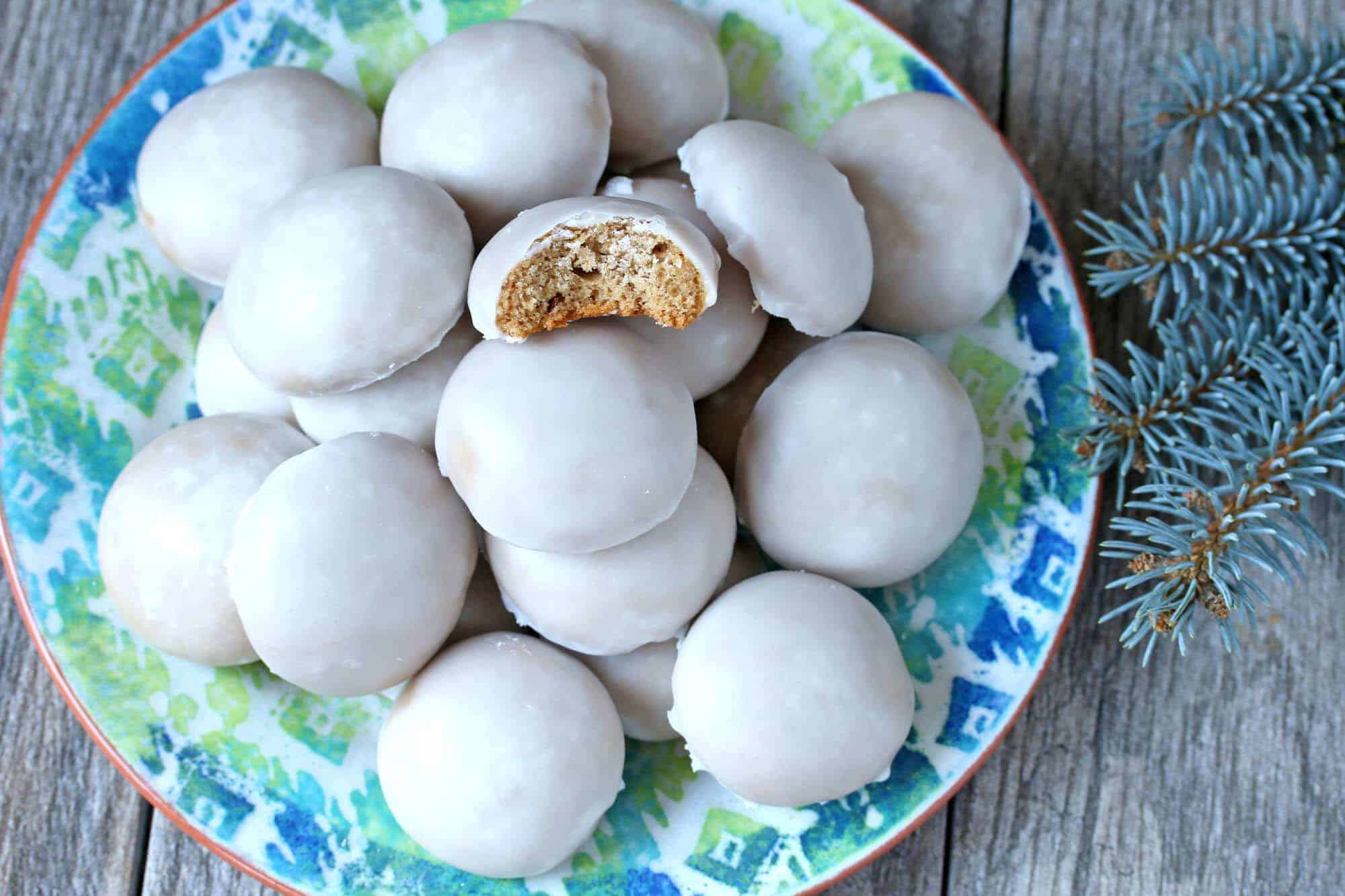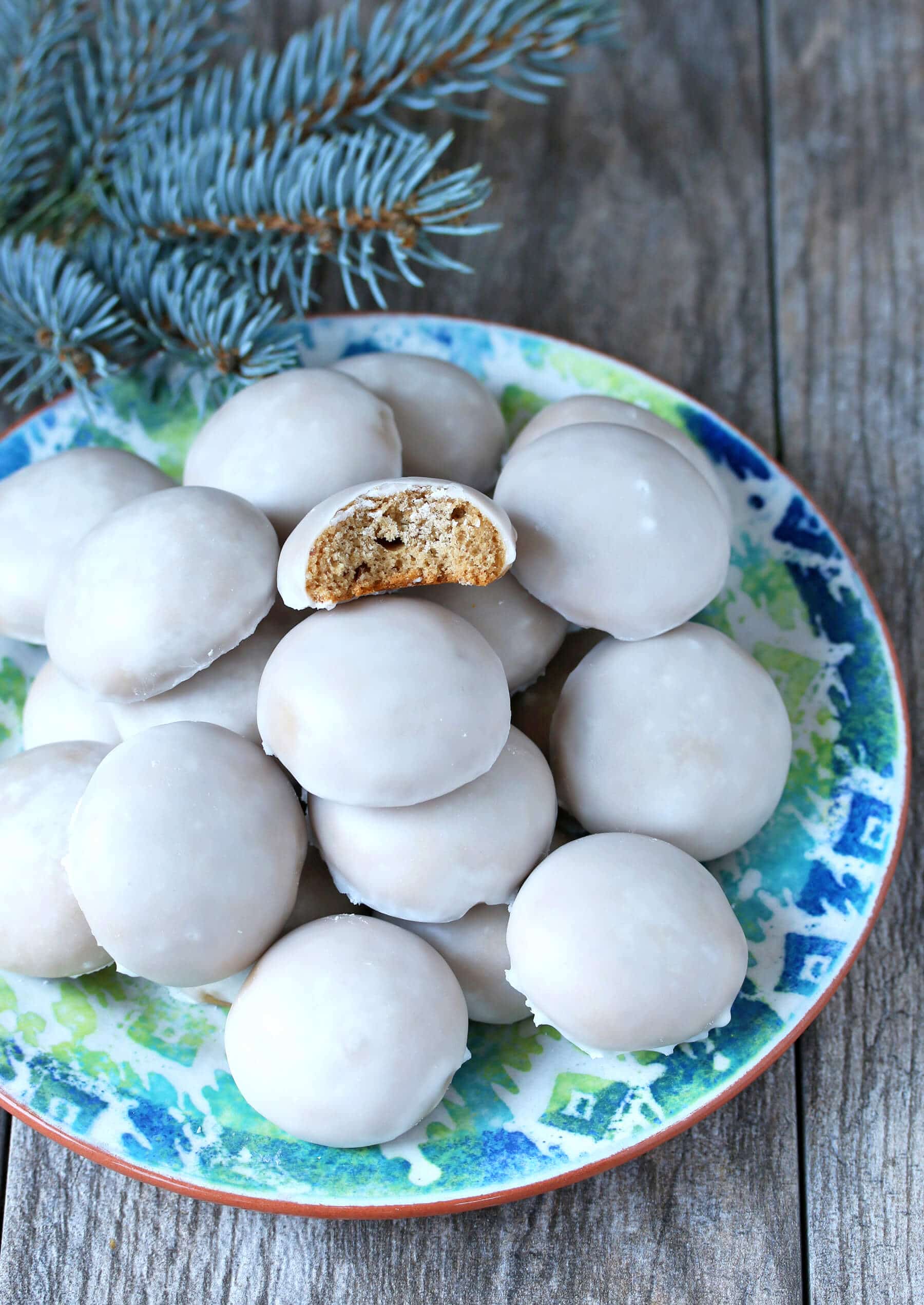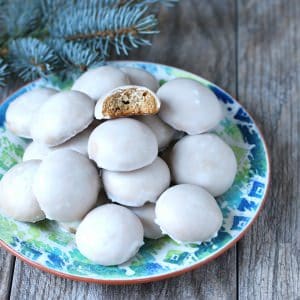Authentic Pfeffernüsse
This post may contain affiliate links. See my disclosure policy.
One of Germany’s most popular and beloved Christmas treats, these spiced and iced cookies known as Pfeffernüsse are simply delightful! A thoroughly authentic and incredibly delicious homemade Pfeffernusse recipe that will bring back fond memories or help create new holiday traditions!

What Are Pfeffernüsse?
The Netherlands and Germany enjoy a similar cookie in the month of December. Known as Pepernoten in the Netherlands, they are eaten in celebration of the arrival of Sinterklaas on December 5. In Germany they are known as Pfeffernüsse and although St. Nicholas comes on December 6, Pfeffernüsse are enjoyed throughout the entire Christmas season.
The coming of the jolly bearded man so early on in the month will sound confusing to those who await Santa on December 25. But in Germany, and many other European countries, the tradition is that St. Nicholas visits the kids earlier in December. Traditionally shoes are left in front of the door and if you’re good they’ll be filled with oranges and nuts – if you’re bad, you’ll get shoes full of coal. Then, on Christmas Eve, it’s not Santa who comes to the home to deliver gifts, it’s the Christkind – the Christ child, the ultimate Giver – who gives the gifts.
Pepernoten and Pfeffernüsse are both spice/gingerbread-like cookies and have some similarities, but the ingredients vary as does the method of preparation. Also, Pfeffernuesse are commonly coated with a sugar icing. The name Pfeffernuesse means “pepper nuts.” The pepper part refers to the white pepper that is added to the dough which gives these cookies a very unique and flavorful touch. The nuts part refers to their walnut-like shape.
In Germany you can find Pfeffernusse in any grocery store throughout the holidays. I have to admit, as popular as they are I’ve never cared for store-bought Pfeffernusse. And so if you were to tell me you don’t like them either I would understand. BUT…homemade is a totally different story. Everything about homemade Pfeffernusse is better – the flavor, the texture. In short, if like me you don’t like the store-bought stuff, give these a try – I think these German spice cookies will win you over!

Pfeffernüsse Recipe
Let’s get started!
In a small bowl, combine the flour, baking soda, salt, Lebkuchengewürz, white pepper and almond meal. Set aside.
Combine the brown sugar, honey, butter, and cream in a medium saucepan and heat, stirring frequently, until melted and the sugar is dissolved.

Remove from heat and let sit 5 minutes. (Note: While not traditionally included, for some added flavor and texture you can also stir in some finely chopped Candied Orange Peel or Candied Ginger.)
Stir in the flour mixture.

Stir in the egg until thoroughly combined.
The dough will have a nice glossy sheen. The dough will be very sticky and that’s how it should be.

Turn the mixture out onto some plastic wrap and wrap the dough tightly. Refrigerate at a minimum overnight to allow the flavors time to develop, or for up to two days.
Remove the dough from the plastic wrap and immediately roll it into two strands, each 3/4 inch thick. Slice the rolls into 3/4 inch thick rounds.
Roll each round into a ball (each ball should be about 3/4 inch large). Work quickly while the dough is still chilled.

Place the cookie balls on a line cookie sheet and bake for 15 minutes or until golden brown.
Remove and let the cookies cool a few minutes before transferring them to a wire wrack to cool completely.

To make the glaze, combine the powdered sugar and water until smooth.
Dip each cookie in the glaze, letting the excess drip off, and place them on a wire rack positioned over a cookie sheet (to catch the drips).

Repeat for all of the cookies and let the Pfeffernusse sit until the glaze is fully hardened.
Store the cookies in airtight container in a cool place.

Pfeffernusse will keep for at least 2 weeks and the flavor only gets better over time. Enjoy them on their own or dunked in your favorite hot beverage.
And be sure to check out all of my favorite traditional German Christmas Cookies!
Enjoy!

For more authentic German Christmas recipes try my:
- Stollen
- Lebkuchen
- Engelsaugen
- Marzipan
- Springerle
- Gugelhupf
- Dampfnudel
- Berliner Brot
- German Rum Balls
- Printen
- Speculoos
- Vanillekipferl
- Zimtsterne
- Bethmännchen
- Heidesand
- Kokosmakronen
Save This Recipe

Authentic Pfeffernüsse
Equipment
Ingredients
- 2 1/4 cup all-purpose flour
- 1/2 teaspoon baking soda
- 1/4 teaspoon salt
- 3-4 teaspoons Lebkuchengewürz
- Homemade Lebkuchengewürz (STRONGLY recommended for best flavor), click link for recipe
- 1/4 teaspoon finely ground white pepper
- 1/4 cup almond meal or almond flour (meal has skins intact, flour has skins removed; more aesthetics than anything)
- 1/2 cup packed brown sugar
- 1/3 cup pure honey
- 5 tablespoons unsalted butter
- 3 tablespoons heavy cream
- 1 large egg
- For the Glaze:
- 2 1/2 cups powdered sugar
- 3-4 tablespoons hot water (less water will result in a thicker & whiter glaze)
Instructions
- In a small bowl, combine the flour, baking soda, salt, Lebkuchengewuerz, white pepper and almond meal. Set aside.
- Combine the brown sugar, honey, butter, and cream in a medium saucepan and heat, stirring frequently, until melted and the sugar is dissolved. Remove from heat and let sit 5 minutes. Stir in the flour mixture. Once incorporated stir in the egg until thoroughly combined. The dough will have a nice glossy sheen. It will be very sticky and that’s how it should be.
- Turn the mixture out onto some plastic wrap and wrap the dough tightly. Refrigerate overnight or for up to two days.
- Preheat the oven to 350 degrees.
- Remove the dough from the plastic wrap and immediately roll it into two strands, each 3/4 inch thick. Slice the rolls into 3/4 inch thick rounds and roll each round into a ball (each ball should be about 3/4 inch large). Work quickly while the dough is still chilled. Note: The size is just personal preference, you can make them larger if you prefer.Place the cookie balls on a line cookie sheet and bake for about 15 minutes or until golden brown. Remove and let the cookies cool completely.
- To make the glaze, combine the powdered sugar and water until smooth.Dip each cookie in the glaze, letting the excess drip off, and place them on a wire rack positioned over a cookie sheet (to catch the drips) and let them sit until the glaze is fully hardened.Store the cookies in airtight container in a cool place. Will keep for at least 2 weeks (they're usually stored longer) and the flavor only gets better over time.Makes 50+ cookies depending on their size.
Nutrition
Originally published on The Daring Gourmet December 20, 2015



















Thank you Kimberley for a lovely recipe. I’ve always used my conventional oven for baking but dared to try the convectional oven — thought that perhaps that was the renason for them drying out so much. Got it.
Merry Christmas.
Thank you for the recipe Kimberley. I tried ot today and they were delicious. I have one query though. A friend of mine gave me some of these in a cookie platter last year. I asked her for the recipe but unfortunately she did not make them — bought them from a German store. They were delicious but fairly firm — more towards the hard side. Mine baked softer, a bready te ture. So, I toasted them. What’s the real te ture supposed to be like. Thank you.
Hi Lydia, I’m glad you enjoyed them, thank you! It’s hard comparing homemade baked goods with store-bought ones, there will always be differences. In terms of what the texture is “supposed” to be like, store-bought ones are usually harder, yes; for homemade ones, the texture of these Pfeffernüsse are spot on. Given that traditionally Pfeffernüsse were only made at home and not sold commercially, I guess you could say that the texture of homemade ones is how they’re supposed to be.
This recipe is great, but I think you need to update the instructions for the time to bake for 7 to 13 minutes or something like that. I cooked it twice in two separate gas ovens, and the first batch in the first oven was burned on the bottom and smoking after 15 minutes.
I tried 7 minutes on the second batch in the second oven and it was perfect (medium brown on the bottom and cooked all the way through), so 15 minutes would have burned it the same way again. I cook all kinds of bread in both ovens several times a week and never have issues like this with baking times or temperatures.
15 minutes at 350 seems to be just too long, anyway, compared to other cookie recipes that typically call for 7-12 minutes. With other cookie recipes I do have to cook to the lower end of the time range, which is why I suggest you update your recipe to have a range. This recipe is a bit of work to have it ruined by a timing issue.
Hi Craig, 15 minutes at 350 is standard for Pfeffernüsse and you’ll see that reflected in many other recipes for them. No one else has reported having the issue you’re describing. I noticed you mentioned you have a gas oven and that’s likely where the discrepancy lies. In an electric oven the cookies would be completely under-done within your suggested time range (they’d be raw in the middle at 7 minutes). Gas ovens generally burn hotter than electric ovens do and also tend to fluctuate widely in temperature, often creating “hot spots.” Adjustments are commonly needed in baking times and temperatures with gas ovens.
Aah OK, I suspected 15 minutes would probably have been fine in an electric oven, but wasn’t sure because I haven’t used one in around 25 years. Maybe that’s why most cookie recipes state a time range and you have check the condition of the cookies on the low end of that range to figure out what works for your equipment?
I would still update the recipe bake time for that reason alone. Better to under-bake and bake a bit longer than to over-bake and have an entire batch of cookies ruined. Also, checking a half dozen other pfeffernusse recipes showed a variety of cooking temperatures from 325 to 350 (although most were 350) and times from 9 to 12 and 10 to 15 minutes.
Again, thank you very much for posting this recipe, just a couple of suggestions to update it based on my experience.
FYI, I cooked two more full batches using this recipe to try to get the time down. I confirmed that 11 to 13 minutes was perfect for my gas oven, and at 13 minutes a few of the cookies had very, very dark brown bottoms, but not burned. This was pre-heated for a half hour to an hour, which can make a difference with a gas oven’s cook times, but is important for consistency. So, I’m sure the extra 2 minutes of cook time is the reason why my first batch was completely burned on the bottoms of all the cookies.
One other question on the recipe: do you ice the bottoms of the cookies or just the tops/sides? I can’t tell from any of your pictures or the recipe itself, but store-bought cookies like these are always iced on top and bottom.
Again, thanks for posting this great recipe for the world. It’s the most authentic pfeffernüsse cookie recipe of any I’ve tried. It takes a little work and waiting, but a great tasting family/team cooking recipe. I like to get my kids involved cooking things like this with me.
Wonderful, Craig, I’m so glad to hear that, thank you! Icing the bottom is purely personal preference, no right or wrong about it. After you dip the tops simply flip them around and dip the bottoms before setting them down to dry – there are dipping tools that make this much easier (and cleaner). Thanks again for the feedback!
Another wonderful recipe. I’ve made these twice so far. First time with eggs and almond meal, and then, for my allergic son, without eggs or almonds.
My substitutions: for the almond meal–oatmeal. Gave it a (very!) quick buzz in the coffee grinder to mimic the texture of the almond meal.
For the eggs: chia seeds soaked in a little water.
Dough was not quite as sticky as with eggs and slightly “brittle,” but was still easy to handle. This was also true after the resting time.
I didn’t bake them quite as long, but that’s pretty much always my preference.
They taste great!
Thanks for the feedback about the substitutions, Becky. I’m so glad you enjoyed the Pfeffernüsse, thanks so much!
Oh, that’s good to know. The cracks aren’t super apparent after being glazed, so I guess that will have to be my solution.
Thanks, again!
I’m loving these! They are better than the ones you can get at Trader Joe’s, and I love the Lebkuchengewürz.
I’m having a slight problem though, my cookies keep cracking when they bake, and I don’t know why, or how to fix it.
I’ve also had to make substitutions to the dairy ingredients, because my mother is deathly allergic to dairy products. I’m not sure if the substitutions are contributing to the cracking, or if I’m getting something wrong in the recipe.
The first batch was too dry, but the second batch seemed like the right sticky wet texture.
Any ideas?
Thank you, Ren, I’m so glad you enjoyed them! I’m not sure why the first batch would have been different than the second if you did it the same both times. The cracking – I just experimented making a gluten-free batch of these and they cracked, likely because the GF version is just drier. Also, cookies tend to crack towards the end if they’re over-baked so you may want to check on them a bit sooner.
I added more coconut cream on the second batch, since the first was too dry.
Even at about 8 minutes in the cracks were forming, and they don’t seem overbaked.
The second batch (with added liquid) had a few that didn’t have cracks, and they were not as big and deep as the first.
I guess I’ll have to keep experimenting, to see what works.
Thanks!
I’m thinking it might be a dairy issue, Ren. From a baking article: “The protein in milk creates a strong batter or dough, capable of rising and withstanding the rigors of baking.” There’s not a lot of dairy in these but it may be just enough to make the difference. Something you could try is double dipping the cookies in the sugar glaze after the first coat is dry – that should help cover up the cracks.
One of my test batches cracked, so I knocked the temperature down 5 degrees. Amazingly, thise 5 degrees made a difference. Although they still cracked, the cracks were smaller and as they cooled the cracks closed up again. Just for anyone who is interested, I used whisked egg white with the icing /confectioners sugar instead of water (2 egg whites per cup of sugar). Dipped the warm biscuits in the mixture and put back into the warm (but turned off) oven for 10 minutes with the door open a crack, then left to dry for a few hours at room temp. Perfectly thin, slightly crispy, white shell that wasn’t too sweet. Credit to Brooklyn homemaker website for the idea.
For anyone from Ontario,Canada (Hamilton or Burlington area), I just bought the Lebkuchengewurz spice mix at Denninger’s (a German specialty store) and it’s only $2.99 for a 30g cello pack! I can’t wait to try this recipe!
Hi Kimberly, thanks for much for this recipe-I’ve made my spice blend and ready to start tomorrow. Quick question beforehand though-here in UK we have dark and light brown soft sugar. Which one would you recommend? The dark brown has a more molasses flavour than the light… Also, for the final glaze have you ever done icing sugar and lemon juice? I thought that might work so will give it a try :) thanks!
Simon.
Excellent, Simon! That homemade spice blend makes all the difference. Dark versus light brown – purely personal preference and it honestly won’t make a big difference either way with such a relatively small quantity. I would just use whichever one you already happen to have and if you have both, draw straws or flip a coin ;) You can certainly use lemon juice. I’ve done that for other cookies/biscuits. It just depends on whether you want a lemon-flavored accent to the gingerbread flavor. You can always half with and half without and see which you prefer. Happy baking!